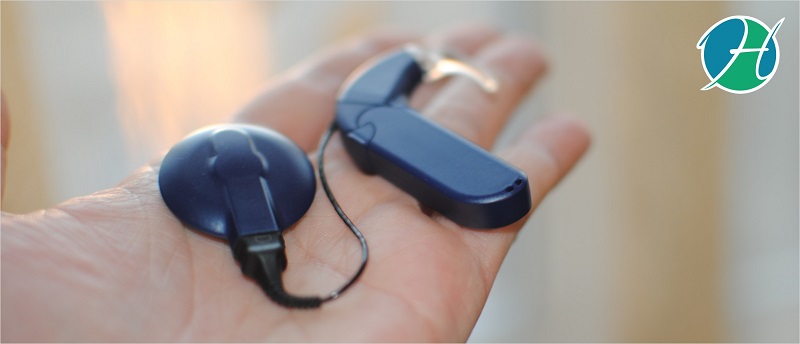Cochlear Implants

A cochlear implant is a small electronic device that provides a sense of hearing to a person who is suffering from hearing loss that cannot be helped by a hearing aid. These people are either profoundly deaf or severely hard of hearing. It works differently from hearing aid as it doesn’t restore normal hearing but it provides some representation of sound present in the environment which would help to understand speech. Therapy courses are required to understand and learn the interpretation of various sounds after implantation.
Eligible people
Those people are eligible for cochlear implants who have damaged inner ear that and lost the ability to convert sound signals into electric signals which nerves can carry up to the brain or people who have intact inner year but still they are not able to relay the sound to the inner portion of the ear. Therefore, the criteria for selecting people for cochlear implantation are:
- Severe to profound bilateral sensorineural hearing loss. It means that both inner ears of the person are damaged.
- No or little benefit to the people after using hearing aid for six months.
According to the FDA, children as young as 12 months are eligible to get cochlear implants. Some adults who have lost their hearing capability later in the life can also get benefit from cochlear implants. Eligibility depends upon many other factors too. So, it is important to have a proper consultation with a healthcare professional because it requires audiological, psychological testing as well as medical exams and imaging.

How does it work?
A cochlear implant consists of an external component similar to a hearing aid which is visible on the outside and internal portion that is surgically placed under the skin.
The external portion consists of
- A microphone which picks up the sound signals from the environment
- A speech processor which filters and processes the sounds picked up by the microphone. Both these unit are placed behind the ear and looks similar to a hearing aid.
The internal portion consists of
- A transmitter-stimulator unit which transmits signals received from the speech processor and help in stimulating the electrodes
- An electrode array which is a group of electrodes that collects signals from stimulator and send it directly to the hearing nerve.
In a normal hearing individual, the sounds signals captured by the external ear are converted into the electric signals with the help of the internal ear. Then these electric signals are carried by the hearing nerve to the brain for understanding. Hearing aid simply amplifies sounds so that external ear can easily captures it but a cochlear implant works very differently from the hearing aid. The implant itself takes over the function of external and internal ear by directly stimulating the hearing nerve. Since the normal biology is bypassed through the help of cochlear implants, therefore, hearing through the cochlear implant is different from the normal hearing. It requires time and therapy to learn and understand the sense of hearing as well as speech.

Preoperative evaluation
Since getting a cochlear implant is a surgical procedure, the patients are checked to identify any congenital malformations, evaluate the patency of the cochlea, risk of infections. It is ensured that an educational rehabilitation program is available that focusses on the auditory and verbal skills of the patient.

Rehabilitation
It involves training the brain for the sound waves which are present in the environment. Since normal sound waves are different from what it is perceived through the cochlear implants, therefore the brain needs time to differentiate between various types of sounds and what these sounds mean.

Prognosis
The long-term outcome is based on the age of implantation and the time period between the hearing loss and the implantation. Children who receive a cochlear implant at a younger age followed by a regular rehabilitation program perform better than the children receiving at an older age. Adults who learned language before losing their hearing have greater success with the cochlear implants as compared to the those who had not developed language before losing their hearing abilities.
Studies have shown that the following types of children had the best outcomes who
- become deaf after the age of two years
- use oral communication
- are implanted at an earlier age
Patients with cochlear implants require regular and lifelong follow up to monitor and management of complications. There are short term complications which are associated with every surgery as well as long term complications. The most common complications are
- Vestibular complications leading to dizziness or balance problems
- Device failure
- Taste problems
- Local infections
References
- Rizer FM, Burkey JM. Cochlear implantation in the very young child. Otolaryngol Clin North Am 1999; 32:1117.
- NIH consensus conference. Cochlear implants in adults and children. JAMA 1995; 274:1955.
- Basura GJ, Eapen R, Buchman CA. Bilateral cochlear implantation: current concepts, indications, and results. Laryngoscope 2009; 119:2395.
- Tomblin JB, Spencer L, Flock S, et al. A comparison of language achievement in children with cochlear implants and children using hearing aids. J Speech Lang Hear Res 1999; 42:497.
- Manrique M, Cervera-Paz FJ, Huarte A, Molina M. Advantages of cochlear implantation in prelingual deaf children before 2 years of age when compared with later implantation. Laryngoscope 2004; 114:1462.
- O’Donoghue GM, Nikolopoulos TP, Archbold SM. Determinants of speech perception in children after cochlear implantation. Lancet 2000; 356:466.

